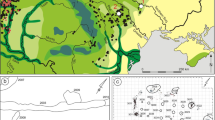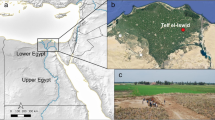Abstract
This paper describes the results of the archaeobotanical examination of four Late Neolithic lakeshore settlements on Lake Biel in Switzerland. Due to the excellent preservation conditions in lakeshore settlements, non-carbonized as well as carbonized seeds and fruits were recovered in large numbers. In addition to the diaspore analyses, some samples of charcoal and moss were identified. The spectrum of cultivated plants was markedly different between the sites. In the transition from the 34th to 33rd century B.C. (sites Nidau, Lüscherz and Lattrigen ‘VI’) naked wheat and barley were predominant, while in the 32nd century B.C. (Lattrigen'VII') emmer (a glume wheat) was most abundant. Flax and opium poppy were of great importance during the whole late Neolithic period. In addition to cereals, a large number of cereal weeds were detected. The wild flora included a high percentage of aquatic and lake-shore plants which results from the strong influence of water on the cultural layers. Taxa of flood-plain forest are also common. The proportion of potential grassland plants was low (in total only 13 taxa) which suggests that in addition to the cultivated fields only few pastures and grassland areas existed close to the settlements.
Similar content being viewed by others
References
Ammann B, Bollinger T, Jacomet-Engel S, Liese-Kleiber H and Piening U (1981) Die neolithische Ufersiedlungen von Twann, Band 14, Botanische Untersuchungen. Staatlicher Lehrmittelverlag, Bern
Ammann-Moser B (1975) Vegetationskundliche und pollenanalytische Untersuchungen auf dem Heidenweg im Bielersee. Beitr Geobot Landesaufn Schweiz 56
Baudais-Lundstrøm K (1978) Plant remains from a Swiss neolithic lake shore site: Brise-Lames, Auvernier. Ber Deutsch Bot Ges 91: 67–83
Behre KE, Jacomet S (1991) The ecological interpretation of archaeobotanical data. In: Zeist W van, Wasylikowa K and Behre KE (eds), Progress in Old World Palaeoethnobotany. Balkema, Rotterdam, pp 81–108
Billamboz A (1990) Das Holz der Pfahlbausiedlungen Südwestdeutschlands, Jahrringanalysen aus archäodendrologischer Sicht. Ber RGK 71: 187–207
Bollinger T, Jacomet S (1981) Resultate der Samen- und Holzanalysen aus den Cortaillodschichten. In: Ammann B et. al ., Die neolithischen Ufersiedlungen von Twann, Bd. 14, Botanische Untersuchungen
Brombacher C (1993) Prähistorische Nachweise der Kretischen Flachsnelke (Silene cretica L.) nördlich der Alpen. Diss Bot 196 (Festschrift Zoller): 491–498
Brombacher C, Jacomet S (1997) Ackerbau, Sammelwirtschaft und Umwelt: Ergebnisse archäobotanischer Untersuchungen. In: Schibler J et al., Ökonomie und Ökologie neolithischer und bronzezeitlicher Ufersiedlungen am Zürichsee. Monographien der Kantonsarchäologie Zürich 26
Dick M (1989) Wirtschaft und Umwelt cortaillod- und horgenzeitlicher Seeufersiedlungen in Zürich. Diss Bot 132
Ellenberg H (1988) Vegetation ecology of Central Europe. 4th ed. (tr. G.K. Strutt) Cambridge University Press, Cambridge
Ellenberg H (1991) Zeigerwerte der Gefäßpflanzen Mitteleuropas. Scripta Geobotanica 9. 2nd ed.
Hafner A (1996) Aspekte der Siedlungsarchäologie des Jung- und Spätneolithikums am Bielersee. In: Studien zum Siedlungswesen im Jungneolithikum. Beiträge zur Ur- und Frühgeschichte Mitteleuropas 10. Wilkau-Hasslau. pp 3–21
Hegg O (1980) Die heutige Pflanzenwelt der Region Biel. Jahrb Geogr Ges Bern 53: 43–70
Hegg O et al. (1993) Atlas schutzwürdiger Vegetationstypen der Schweiz. Bundesamt für Umwelt, Wald und Landschaft, Bern
Hopf M (1968) Früchte und Samen. In: Zürn H (ed.), Das jungsteinzeitliche Dorf Ehrenstein. Veröff Staatl Amt Denkmalpfl Stuttgart, Reihe A, Heft 10/11, pp 7–77
Jacomet S (1987) Prähistorische Getreidefunde. Eine Anleitung zum Bestimmen prähistorischer Weizen- und Gerstenfunde. Skript Botanisches Institut, Universität Basel
Jacomet S (1988) Pflanzen mediterraner Herkunft in neolithischen Seeufersiedlungen der Schweiz. In: Der prähistorische Mensch und seine Umwelt (Festschrift Körber-Grohne). Forsch u Ber Vor- Frühgesch Baden-Württemberg 31, pp 205–212
Jacomet S (1990) Veränderungen von Wirtschaft und Umwelt während des Spätneolithikums im westlichen Bodenseegebiet. In: Siedlungsarchäologie im Alpenvorland II. Forsch u Ber Vor- Frühgesch Baden-Württemberg 37, pp 295–324
Jacomet S et al. (1989) Archhobotanik am Zürichsee. Ber Zürcher Denkmalpfl Monogr 7
Jacomet S et al. (1991) Palaeoethnobotanical work on Swiss neolithic und bronze age lake dwellings over the past ten years. In: Renfrew J (ed), New light on early farming. Edinburgh University Press, Edinburgh, pp 257–276
Jones MK (1991) Sampling in palaeoethnobotany. In: Zeist W van, Wasylikowa K and Behre KE (eds), Progress in Old World Palaeoethnobotany. Balkema, Rotterdam, pp 53–62
Karg S (1990) Pflanzliche Grossreste der jungsteinzeitlichen Ufersiedlungen von Allensbach-Strandbad (Kr. Konstanz). In: Siedlungsarchäologie im Alpenvorland II. Forsch u Ber Vor-Frühgesch Baden-Württemberg 37, pp 113–165
Keller F (1854) Die keltischen Pfahlbauten in den Schweizerseen. Mitteilungen der Antiquarischen Gesellschaft Zürich 9, 3
Körber-Grohne U (1987) Nutzpflanzen in Deutschland. Theiss, Stuttgart
Maier U (1996) Morphological studies of free-threshing wheat ears from a Neolithic site southwest Germany, and the history of naked wheats. Veget Hist Archaeobot 5: 39–55
Neuweiler E (1924) Pflanzenreste aus den Pfahlbauten des ehemaligen Wauwilersees. Mitt Naturforsch Ges Luzern 9: 301–323
Piening U (1981) Die verkohlten Kulturpflanzenreste aus den Proben der Cortaillod- und Horgener Kultur. In: Ammann B et. al. (1981) Die neolithischen Ufersiedlungen von Twann. Bd. 14. Botanische Untersuchungen. Bern
Rösch M (1988) Subfossile Moosfunde aus prähistorischen Feuchtbodensiedlungen: Aussagemöglichkeiten zu Umwelt und Wirtschaft. In: Der prähistorische Mensch und seine Umwelt (Festschrift Körber-Grohne). Forsch u Ber Vor- Frühgesch Baden-Württemberg 31: 177–198
Rösch M (1990a) Veränderung von Wirtschaft und Umwelt während Neolithikum und Bronzezeit am Bodensee. Siedlungsarchäologische Untersuchungen im Alpenvorland. Ber RGK 71: 161–186
Rösch M (1990b) Botanische Untersuchungen an Pfahlverzügen der endneolithischen Ufersiedlung Hornstaad-Hörnle V am Bodensee. In: Siedlungsarchäologie im Alpenvorland Il. Forsch u Ber Vor- Frühgesch Baden-Württemberg 37: 325–351
Rösch M (1990c) Zur subfossilen Moosflora von Allensbach-Strandbad. In. Siedlungsarchäologie im Alpenvorlandll. Forsch u Ber Vor- Frühgesch Baden-Württemberg 37: 167–172
Schlichtherle H (1981) Cruciferen als Nutzpflanzen in neolithischen Ufersiedlungen Südwestdeutschlands und der Schweiz. Z Archäol 15: 113–124
Schlichtherle H (1985) Samen und Früchte. Konzentrationsdiagramme pflanzlicher Grossreste aus einer neolithischen Seeuferstratigraphie. In: Strahm C, Uerpmann HP (eds), Quantitative Untersuchungen an einem Profilsockel in Yverdon, Av. des Sports. Freiburg i.Br.
Veen M van der (1987) The plant remains. In: Heslop DH, The excavation of an Iron Settlement at Thorpe Thewles, Cleveland, 1980–1982. Counc Brit Archaeol Res Rep 65: 93–99
Willerding U (1991) Präsenz, Erhaltung und Repräsentanz von Pflanzenresten in archäologischem Fundgut. In: Zeist W van, Wasylikowa K and Behre KE (eds), Progress in Old World Palaeoethnobotany. Balkema, Rotterdam, pp 25–51
Winiger J (1989) Bestandesaufnahme der Bielerseestationen als Grundlage demographischer Theoriebildung. Ufersiedlungen am Bielersee Bd. 1, Bern
Wohlfarth B, Schneider AM (1991) Late Glacial and Holocene Litho- and Biostratigraphy of Lake Biel, Western Switzerland. Bull Soc Vaud SC Nat 80: 435–457
Zohary D and Hopf M (1993) Domestication of plants in the Old World. 2nd ed. Clarendon Press, Oxford
Author information
Authors and Affiliations
Rights and permissions
About this article
Cite this article
Brombacher, C. Archaeobotanical investigations of late neolithic lakeshore settlements (Lake Biel, Switzerland). Veget Hist Archaebot 6, 167–186 (1997). https://doi.org/10.1007/BF01372569
Received:
Accepted:
Issue Date:
DOI: https://doi.org/10.1007/BF01372569




